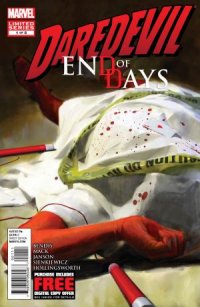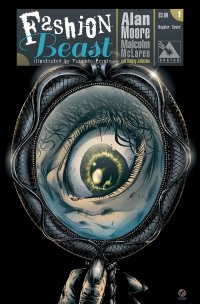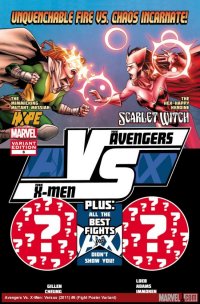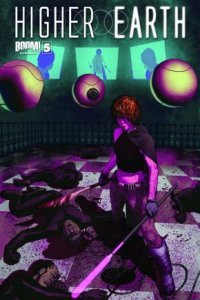Daredevil: End of Days #1 of 8 (Marvel, $3.99)
By Jeb D.
Every now and again, it’s nice to know that spending the past decade or so moving the pieces around on Marvel’s spandex chessboard hasn’t completely blunted Brian Bendis’ strengths as a writer: for whatever questionable decisions he might have made with the various incarnations of the Avengers (and, to be fair, some are probably editorially mandated), you still get the occasional Scarlet, Moon Knight, or Takio poking through. When Daredevil: End of Days was originally announced years ago (even before the Halo debacle), this was going to be the ultimate meeting of a lifetime’s worth of hornhead minds, becoming, so to speak, the he be-all / end-all of Marvel’s entire “The End” concept. And maybe the fact that it didn’t quite turn out that way isn’t such a bad thing: after all, the artist jam for the 50th issue didn’t turn out all that well (the evident fact that no one bothered to send Gene Colan a précis of the storyline, or even a description of Bendis’ version of the Kingpin, was just embarrassing). Instead of a creative monster rally, what we have here is the opening chapter in another excellent hard-boiled Daredevil storyline with a tight, co-ordinated creative team; David Mack is credited as co-author (Bendis is nothing if not loyal to his friends), and Alex Maleev provides some covers, but for the most part this is Bendis in vintage form, working with penciller Klaus Janson (abetted here and there by Bill Sienkewicz), who has simply never been better.
Once again, our window on Daredevil’s world is Daily Bugle reporter Ben Urich, and it’s a world that has proceeded down a path of ugliness of a piece with the great Bendis/Maleev run on the book. Only inertia, and stubbornness of J. Jonah Jameson has kept the Bugle going, and in its death throes, it runs up against its biggest story in years: the murder of Matt Murdock / Daredevil in public battle with Bullseye… which is not a spoiler, as this is the opening scene of the book, and this side of something like Crossed or Aaron’s Punisher MAX (Bullseye again!), it’s as bloody and disturbing a scene as you’ll encounter in today’s comics. There’s no shortage of brutal fight scenes in the collected Bendis corpus, but Janson’s work here ups the ante; this whole issue is up there with anything Janson has done in his long career; as is the dark, and brutal coloring from Matt Hollingsworth.
Naturally, Jameson demands that Urich use his previous connection with the late Murdock to write the story, and Bendis’ portrayal of the reporter’s crisis of conscience justifies his penchant for coming back to pet characters again and again: for all of Urich’s ubiquity, he’s never been portrayed in more devastating fashion; I won’t spoil some of Bendis’ rhetorical choices for expressing it, but he manages to make reading a fairly depressing interior monologue into a real delight. Things may or may not be what they seem, there’s layers of mystery to unfold, and eerie echoes of a classic film are worked cleverly into the story.
Frankly, the long delays on this project left me wondering if it could possibly live up to its promise, and there’s obviously still a long way to go; but if, by the end, we have a Daredevil story worthy to stand with Born Again or Underboss, I won’t be at all surprised.
Rating: 




Out of a Possible 5 Stars
Fashion Beast #1-2 (Avatar, $3.99 each)
By Adam Prosser
Even if it’s rarely expressed in such bald terms, the underlying assumption of most countercultural movements—in art, music, and fashion—is that they portray a certain level of authenticity. Whenever the mainstream culture starts to become too decadent or full of itself, there’s always some subversive type ready to come along and blow it all up, usually by tapping into whatever’s going on at street level. And of course the style mavens and teenagers are quick to follow, because at the end of the day, if you can find a way to combine cutting-edge style with populism, you’ve achieved the highest rung of coolness. You’re a visionary AND a man or woman of the people. A person who sets the trends, but hasn’t lost sight of where they came from (which is always “the streets” in some form or another.)
Of course, the fact of the matter is that this kind of cultural posturing is just as contrived as any corporate product, no matter how far artists may go in pursuit of capturing truth. I don’t mean that in a bad way; without contrivance, you have no art. And that’s true of punk rock as it is of anything else, for all that “punk” has become a byword for the challenging, emotionally raw, or seemingly artless. Punk rock was in fact carefully crafted—its look, its sound, its attitude—and the man who did most of the crafting was Malcolm McLaren, fashion designer and manager of the New York Dolls and the Sex Pistols. As the owner of “Sex”, the fashion store in Chelsea that became a crucial hub of British punk culture, McLaren and his partners essentially designed what we think of as the punk rock look—mohawks and died hair, leather, chains, piercings. As manager of the aforementioned bands he locked in the punk attitude. In a very real sense, he created the Platonic ideal of counterculture. It’s hard to imagine any one person nowadays having this much of an impact on the way we look, the way we dress, what we listen to.
In 1985, McLaren turned his eye towards a new medium, with the ambition to make a movie that would translate some of his ideas into narrative form. Oddly enough, rather than turning to an established scriptwriter, McLaren ended up working with Alan Moore, who was possibly at his hottest (this was right before Watchmen came out). The partnership was apparently quite profitable, resulting in a 200-page script called Fashion Beast that was apparently written with the same level of obsessive detail as Moore’s usual comic scripts, resulting in McLaren apparently cracking that he’d left nothing for the director to do. Perhaps that’s why the film was never made; Moore has said since that he’s lost interest in the medium of film (though that was after the numerous Hollywood debacles that we all know and loathe). McLaren apparently floated the idea of turning the script into a comic (he died in 2010) but it took Avatar, with its apparent determination to make sure every tiny bit of apocrypha Moore’s ever worked on gets a release, to get it done. (And yes, this is apparently with Moore’s blessing.)
Fashion Beast is set in a near-future setting, though this manifests itself almost entirely in some unique cultural tics and rumours of war on the radio (Moore’s, and the counterculture in general’s, mid-80s obsession with nuclear Armageddon peaks through here and provides an ominous bit of foreshadowing). In many ways, this could simply be taking place in a very stylish section of our own world. In this unnamed city, the skyline is dominated by the clothing factory of Jean-Claude Celestine, an as-yet unseen recluse who plays with tarot cards and dictates style from his godlike viewing gallery, managing everything through two goblin-like women, Madam D. and Madam S. Meanwhile, the story revolves around Doll Seguin, an acid-tongued transvestite who loses hir job in a nightclub due to malicious sabotage by a tomboyish patron, only to be presented with an even better opportunity when Celestine selects hir as a potential “mannekin” (model). The only problem is that this means working with the same girl who got hir fired…
Technically, Moore didn’t write this comic—it’s a sequential adaptation of his script by Anthony Johnson, who also turned Moore’s short story The Courtyard into a comic a while back. (That was the comic to which Neonomicon provided the sequel.) However, as mentioned, Moore apparently went into his usual byzantine level of visual detail in the script, and this appears to be a very faithful adaptation, so the feel of a Moore script is very much here, in inventive visual sequences like the one where we watch most of the main characters getting dressed for an evening out. (As you can probably guess, the theme of clothing shaping our identities is pushed hard right from the beginning.) Artist Fecundo Percio proves to be a good fit, as well, though he and colorist Hernan Cabrera arguably emphasize the grit and grime of the impoverished streets at the expense of the glamour and spectacle of the fashion world…but then, that may be intentional. This IS a story by two people deeply rooted in the punk movement, after all. At the same time, Percio has a gift for characterization and “acting”, and he does a great job drawing Doll as a drag queen who can *just* pass as a woman, while making it clear there’s something just a little off about hir.
If there’s a slight flaw in this, it’s that the pacing is more suited to a film than an Alan Moore comic, which is usually hyper-dense (it’s slated as a 10-issue miniseries); but then, this clearly would have been a hyper-dense film, so the result is still more idea-packed and full of incident than any random DC or Marvel comic you could name. It’s also kind of amusing that such a crucial cultural artefact is coming out from such a C-list publisher…but then, that’s punk rock for you.
Rating: 




Out of a Possible 5 Stars
Avengers VS X-Men: VS #6 of 6 (Marvel, $3.99)
By Jeb D.
If you’re a typical reader of this column, you’ve pretty much ignored Marvel’s current Avengers vs X-Men crossover; and while I’ve been following it in a sort of desultory fashion, I can’t blame you. But not even the most dedicated reader of the series would have expected it to end like this… well, OK, technically, it “ends” with the final issue of Avengers vs X-Men proper, but as far as I’m concerned, everything a crossover like this could or should have been is summed up in this issue.
Up to this point, the “VS” titles have each contained two short stories, of varying quality, that focus on more detail of the fight scenes in one of the main issues of the crossover. This time, two’s not enough: VS #6 contains a fistful of stories, some just a page long, each one offering a sly bit of commentary on the parent series, and featuring a few favorite creators we just don’t see enough of. Kieron Gillen’s Hope / Scarlet Witch showdown that opens proceedings is the longest (largely to make room for the Jim Cheung’s lavish art), offering an on-the-nose (so to speak) riff on Wanda’s famous “No more mutants.” Following that, we have the welcome reunion of Brian Bendis and Jim Mahfood as Captain America and Cyclops distill the whole crossover to its silliest foundations in a single page. Kathryn and Stuart Immonen offer a science-character encounter that tweaks the vintage “everyone explains what the hell they’re doing while they fight” trope. Mike Deodato’s offering is basically one purty splash page with a lovely bit of snark; Ed McGuiness gives us catsuited Domino outwitting Red Hulk; Jarvis gets to shine in a one-pager from Christopher Hastings and Jacob Chabot; and Jason Aaron pits the awesomeness of Iron Fist against the uber-cool of Iceman, with appropriately chilly art from Ramon K. Perez.
But my two favorites are the brilliant version of Hawkeye’s un-PC daydreams, realized by Jeph Loeb (no, really), with positively luscious visuals from Art Adams; and the funny, slyly charming, concluding story from Dan Slott and Katie Cook, who give us their version of how this mess got started in the first place.
Not only is this issue a complete delight, but when was the last time you got 22 pages of Marvel comics without an appearance by Wolverine or Spider-Man?
Rating: 




Out of a Possible 5 Stars
 Higher Earth # 5 ($3.99, Boom!)
Higher Earth # 5 ($3.99, Boom!)by D.S. Randlett (@dsrandlett)
The multiverse has gotten a lot of renewed press lately. A lot of us were probably first introduced to the idea via DC’s efforts to make their “imaginary stories” somehow canon. That or Sliders. In a way, it’s something that human beings are wired to see. Something that separates us from animals is that we can perceive possibility and imagine outcomes. As far as we can currently tell, the smartest animals on Earth have good memories, but their mental experience starts in the present and goes backwards. Story itself is a “gaming” of this human instinct, and from there it’s easy to suggest a Universe that contains all story. All imaginable possibilities might be true. So when physicists like Brian Greene suggest that multiple universes might be a real, physical phenomenon, it’s hard not to jump on the bandwagon.
So it all begs the question: Is there a universe out there where the phrase “perfect jumping on point for new readers” is true? The fifth issue of Higher Earth has been billed as such, but I felt particularly lost. There’s a lot that is good about this comic book, but as a jumping on point this issue just doesn’t serve its purpose. But you can feel it trying. Writer Sam Humphries manages to pack in lots of exposition about the rules of his multiverse, but this is the wrong sort of exposition. New readers will get a feel for how his version multidimensional travel works, but have no sense of context for the conflict or characters.
It’s not all bad news as far as the story is concerned, however. What is there is actually a pretty good scifi yarn about a young woman growing up as a member of a weird, alternate Earth cult. It’s a story about her physical liberation, but the story leaves a considerable amount of doubt as to whether she will ever be mentally free. Most of the characters here are intentionally and believably despicable, which is refreshing in a medium and a genre that typically goes of its way to make its characters likable and able to be identified with. But without a proper sense of context, it all just feels adequate rather than properly good.
Joe Eisma’s art fares a bit better. He reminds me of an artist like Francis Manapaul, but not as well developed. His style is appealing, but can at times feel weightless and a little bit unnatural. He’s great at drawing quizzical expressions, but seems to falter when it comes to more concrete emotions like rage or malice.
Higher Earth #5 isn’t quite the “perfect jumping on point” as advertised, but I suppose that it’s good enough for what it is. If anything, I have half a mind to check out earlier issues and see if there’s more here, and that’s at least a little something.
Rating: 




Out of a Possible 5 Stars